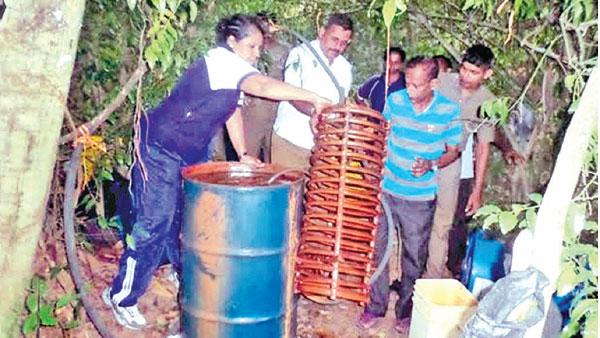
Research shows that artificial toddy contains a very high level of ammonia. According to the Sri Lanka Standards Institution (SLSI), the approved level of free ammonia in drinking water is 0.06mg per litre.
However, SLSI had found over 787mg of free ammonia which is about 12,975 times than the presumable level for drinking water in illicit toddy, which means it is highly unhealthy for human consumption.
In a desk study to find whether there are similar products with high ammonia, researchers found that there weren’t any. There was also no evidence to find research results on the harms of high oral ammonia consumption.
Hence, research to find the co-relationship between the presence of ammonia in illegally manufactured products with c (CKDs) has begun.
In the last two decades, chronic kidney disease of unknown etiology hasemerged as a significant contributor to the burden of Chronic Kidney Disease (CKD) in rural Sri Lanka. It is characterized by the absence of identified causes for CKD. The prevalence of CKD is 15.1–22.9% in some Sri Lankan districts, and previous research has found an association with farming occupations.
According to medical officers, oral consumption in high concentrations of ammonium nitrate may cause headache, dizziness, abdominal pain, vomiting, heart irregularities, convulsions, collapse, and even death.
The basic ingredient in vinegar and arrack is natural toddy. However, with the high demand for cheap alcohol and illegal manufacturers producing toddy (which is a natural product) artificially by fermenting the mixture of sugar, urea and yeast. To speed the fermenting process these illegal distillers use barbed wire and old toxic cell phone batteries. Such toddy comes to the market in four ways -
- For direct consumption as bottled toddy or tavern toddy.
- Companies that manufacture low quality arrack use these as mandatory ingredients. To label a product as ‘Arrack’ it is mandatory to have ‘Coconut toddy’. This illegal toddy is “positioned as coconut toddy and added to arrack with a minimum content of 3% alcohol.
- Over fermented toddy becomes vinegar and is packed as ‘Natural Vinegar’.
- Finally the entire moonshine industry is based on the same fermenting process to produce alcohol of illegal distillation.
Most of the illegally manufactured liquor come to limelight when there are mass fatalities due to poisoning, which reported in various occasions in the past but focus on the longer term harm on the human body is rarely explored and awareness levels in public is very low.
Apart from the fatalities reported due to Methanol intoxication, this story will focus more on the relationship which can have on Chronic Kidney Diseases (CKD) which is a national issue and the consumption of products using illegally manufactured toddy based products.
Hence it is vital to understand the sources of harmful substances in the illegally produced toddy based products. In the process of producing alcohol, yeast cell releases alcohol by fermentation. Yeast needs sugar/carbohydrates and a nitrogen source for cell growth and for fermentation. When yeast utilizes the total fermentable sugars, whatever the nitrogen left in the medium will remain. When considering the illicit alcohol industry, the leftovers are ammonia and urea and all chemicals added during the process.
The leftovers contain whatever the chemicals contained in the urea, mainly ammonia and other heavy metals used for granulization and the chemicals added as batteries and barbed wire.
The danger with illicit alcohol is that the consumer does not know what substances were used to produce it, or indeed how much alcohol is present.
As a result the glyphosate ban was implemented by the Government to prevent chronic kidney disease (CKD) that is widespread in the North Central Province in the country. Hence this was the only preventive action taken on the issue that authorities decided to further investigate.
(Courtesy: SLSI)
